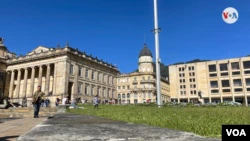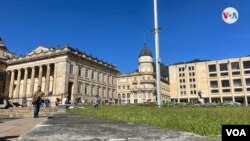– Does the president live in that house?, murmurs a dark-haired woman, while looking carefully at the Casa de Nariño.
– Yes, the president lives there. Linda, isn’t it?, answers another woman who accompanies her.
– Yes, but I like that building over there more, what will it be called?, he answers, while with his index finger he points to the Colegio Mayor de San Bartolomé, one of the oldest in Colombia.
Thus, curious and expectant visitors walk and murmur through the Plaza Nariño, in Bogotá. Although it looks like just another park in the center of the Colombian capital, it has witnessed important historical events in the country and has now become the meeting place for ordinary citizens.
Located between the presidential residence in Colombia, the Casa de Nariño and Congress, it had been closed, in the midst of the conflict that the country has experienced for half a century, for security reasons. After 20 years, it was opened to the public by order of the government of President Gustavo Petro.
“The Núñez square and the park between the seventh and eighth avenues are open to the public and free transit. This pedestrian promenade will be a beautiful route to relax. Public space is always a democratic space and increases the quality of life,” the president wrote on August 11 through his Twitter account.
The reason: the new administration wants to demonstrate that “it is a government of the people and with open doors,” indicates another tweet from the Administrative Department of the Presidency.
It is “a good move by the Petro government to make it understood that the presidency and power are more and more open to the people,” says Juan Esteban Moreno, a jurisprudence student who, although he knew the square, had not been able to admire the beauty of the place and affirms that it is “excellent that they have opened it”.
However, although it was unknown to some, they are pleased with the good news.
For example, Julián David Salazar, a 23-year-old political scientist, confesses that he was completely unaware of its name and location, but now he visits it repeatedly to de-stress from work, because he finds it “an interesting space, very well cared for.”
“Beyond all this, it is a space to be able to resume the spaces of citizenship, which are part of the cultural heritage of the nation. A very nice space, parallel to the Plaza de Bolívar”, said the citizen to the Voice of America.
An opinion shared by the history teacher María Alejandra López, because she says that she loves seeing how people enjoy themselves, “she feels part of all this, which in reality belongs to all Colombians.”
Although he did not know what it was about, he was surprised to see curious people of all ages: “There is a school that I saw somewhere that came for a walk, so adults, children, there are dogs out there… Everyone We come to see what this new space is about. In addition, that it is super green and everything around it is super beautiful, ”she affirmed to the VOA the 30-year-old woman.
The history
The square receives its name in honor of Rafael Núñez, president of Colombia four times (between 1880 and 1894). He, immortalized in the square, through a statue -which arrived in 1960- and that looks reflectively towards the National Capitol, was also a hero of independence, author of the lyrics of the Colombian anthem. he father of the 1886 constitution and translator of the Declaration of the Rights of Man and of the Citizen.
Around the square, emblematic institutions and museums of Colombia lie that can now be seen up close.
If we see the Casa de Nariño from the front, on the right, on the eighth avenue, is the tower of the Astronomical Observatory, built by the doctor and botanist José Celestino Mutis, between 1802 and 1803, declared a national monument of Colombia. Nearby is the headquarters of the Ministry of Culture, and right next to it, the old temple, today the Santa Clara Museum, built between 1619 and 1647.
In front of the presidential house is the National Capitol, the most important civil building built between the 19th and 20th centuries and the seat of the Congress of the Republic. Nearby is the Colegio Mayor de San Bartolomé, one of the oldest in Colombia, since it was built in 1604 and opened its doors the following year.
And the 360-degree tour is closed by the new Congress building, built in 2006, where the offices of several legislators are located. A curiosity: under the Plaza Núñez, a tunnel was built that connects one end of the Capitol with this building.
The square has also witnessed the emergence of the 1991 Constitution and the change of 27 governments in Colombia, as it is through this passageway that the new heads of state enter the presidential residence every four years. .
The plan
Large, short, fat, skinny, young, old, nationals, foreigners. Everyone comes to the square to browse, to learn, to take a breather, to walk, to take photos, to meet again, to eat or even, why not? To ask for marriage, just as a photographer, former guerrilla and signer of the peace agreement did last week, when she took out the ring in the middle of the square, kneeling in front of her girlfriend, according to a video that went viral on networks social.
And it is that the square – patio or small square, as some call it – lends itself to everything. Its beautiful gardens that combine with the colonial buildings are now witnesses, not only of historical events, but also of tourists who arrive expectantly with their guides; workers and students, who pass by for a short break, of entire families who come to enjoy a different weekend. Couples taking photos or friends just wanting to chat.
Even solitary individuals who prefer to walk, admire the landscape and meditate, such as law student Óscar Iván Torres, who told the VOA that “all Colombians should have the opportunity to come to enjoy and visit these spaces that belong to the community… I had seen it from afar, but I had not had the opportunity to enter and, well, one comes, admires the monuments, this sun which is great for taking photos. Being with friends seems super cool.”
There are also those who get to see, with amazement and admiration, the changing of the Presidential Guard in the Casa de Nariño, which takes place on Wednesdays, Fridays and Sundays.
In short, the plans are endless and accessing them only takes a couple of minutes, because to access the square -which opens every day from 6 in the morning- it is enough to allow a security search at the entrance. Of course… do not forget to take your camera, any corner will be a great setting to immortalize a good memory of this historic place.
Connect with the Voice of America! Subscribe to our channel Youtube and turn on notifications, or follow us on social media: Facebook, Twitter and Instagram.












Add Comment